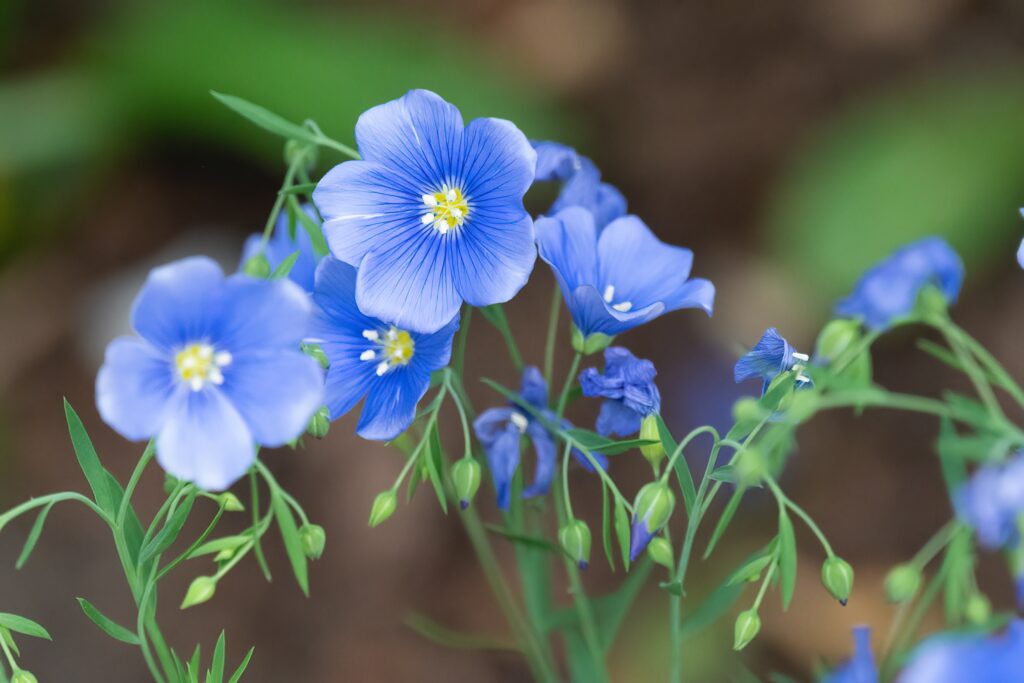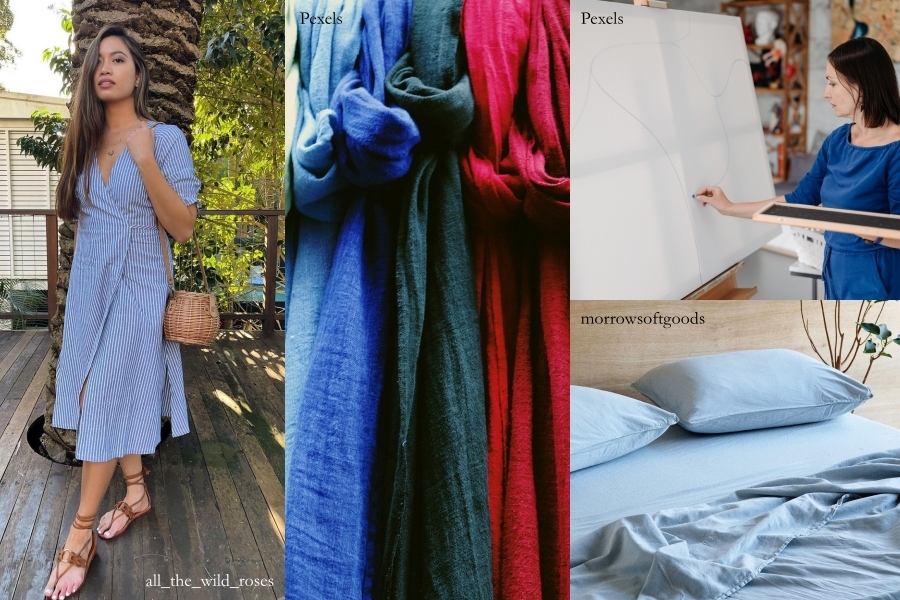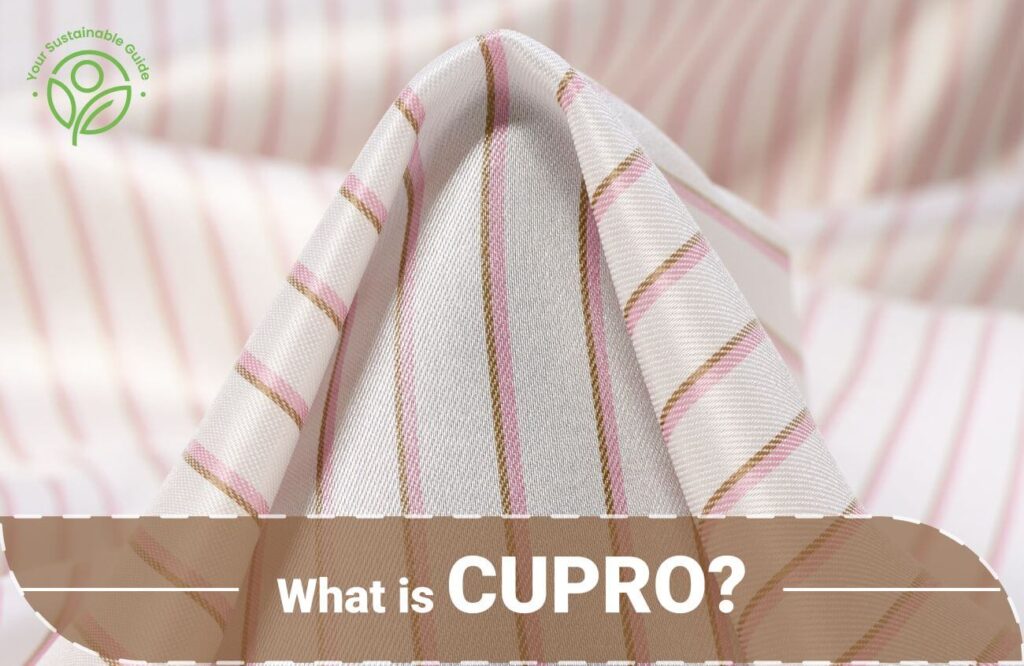En route to building a sustainable wardrobe? Welcome aboard! Because you are in for a ride. In our journey of covering sustainable fabrics to help you choose better, today’s feature will be all about the most sought-after summer essential, Linen fabric. So let’s get started!
Think linen; and my mind is straightaway transported to sunny breezy summers, as the flowiest skirts and the most breathable tops can be made only with this godsend fabric. From wrapping up mummies in ancient Egypt to baby Jesus in Jerusalem, linen fabric had been the go-to material used in different parts of the world since the old times. However, this ancient fabric’s eco-friendly properties gained popularity only a couple of decades back. So let’s find out if linen is really a sustainable fabric.
What is Linen Fabric?
Linen fabric is a completely natural fiber obtained directly from the flax plant. It is a durable, extremely strong, and lightweight fabric that makes an essential part of summer garments and bedding because of its ultimate level of cooling and breathability factor. Linen is similar to cotton, but harvesting and converting the flax fiber into usable linen fabric is a rather long, resource-intensive, and arduous process compared to cotton.
‘Linen’ is derived from the Latin name of flax, ‘Linum Usitatissimum.’ This luxurious fabric is widely used in everyday clothing in regions that experience a hotter climate. People living closer to the equatorial areas benefit greatly from linen’s high moisture-wicking and low moisture-retaining profile. In addition, the natural white color of this fabric reflects heat-inducing solar rays.
Anthropological evidence collected to date points out that, about 35,000 years ago, textiles were made with linen fabric by the Neolithic people in Europe, making linen one of the longest-produced textiles in history. During 8000 BC, linen fabrics became a staple in Egypt because of the hot Egyptian climate. They used it in making clothing, as a currency in the barter system, and even in wrapping up mummies, then prevalent in Ancient Egypt.

Linen was also used by the ancient Greeks in making clothing and home textiles and later on the fabric was introduced in Western Europe. In the 18th century, Ireland became the center of European linen production, where the linen trade thrived throughout the colonial era. But with the introduction of cotton, having similar properties to linen yet being cheaper and easier to produce, linen production gradually saw a decline.
Did you ever notice that ‘laundry’ is often referred to as ‘linens?’ Have you ever wondered why? Well, It’s because linen fabric has a history dating back thousands of years. It is regarded as one of the most ancient fabrics, so much so that the term ‘linens’ eventually became interchangeable with ‘fabric.’
In these modern times, linen is treated as a niche fabric that is produced to manufacture a handful of textile products because of the laborious and time-taking processes used to make this fabric. At present, China is the largest producer and exporter of linen, followed by Italy in the second rank.
How is Linen Fabric Made?
Linen fabric is primarily made from cellulose fibers obtained from flax plants. The production process begins with planting flax plants in moist soil in cold and humid regions, and they get ready to be harvested in about 100 days.
Flax plants can’t grow efficiently with weeds around, so herbicides and tilling are necessary to get abundant yields in flax crops. Once the stems of the plants turn yellow and the seeds become brown, the flax plants are ready to be harvested.
After harvesting, the plants go through the process of removing leaves and seeds, and the fibrous stalk from the flax plants’ woody inner part is also separated. This process is known as retting and must be done skillfully to avoid any damage.
Now, the decayed flax stalks are torn apart to separate the usable inner fibers and the unusable outer fibers. Usually, this step is done by crushing the stalks using rollers and removing the outer fibers with rotating paddles.
Next, the inner fibers are combed to achieve thin strands, which are now ready for spinning. In olden times, flax yarn was spun with a foot-powered flax wheel, but as times changed and technologies evolved, linen producers now use industrial spinning machines for this process. After the threads are spun, the linen yarn is reeled onto a bobbin.
The reeling process is done in damp, humid conditions to secure the flax yarn from falling apart. Furthermore, the spun yarn goes through a hot water bath to ensure the threads are closely-knitted, followed by drying the finished yarn and reeling it onto bobbins.
Finally, linen yarn is ready to be dyed, treated, and used to make various textile products.
Is Linen Fabric Sustainable?
Yes, linen fabric is sustainable. It is made from flax plants that thrive in cool, humid climates with moist and well-plowed land found in Europe. Although Belgian flax is famed to be of the finest quality, flax is also harvested in the Netherlands, Denmark, Italy, Poland, Austria, Switzerland, France, Spain, and the British Isles. Flax plant does require pesticides as it doesn’t grow well in presence of weeds, but the water consumption is the bare minimum (rainwater tends to be enough) if compared to cotton.

The entire flax plant is used for multiple purposes like flaxseed food products, flaxseed oil, Linseed oil used for furniture, etc. so once harvested, every bit of the flax plant is used. According to the European Confederation of Linen and Hemp CELC, flax plants are amazing for our planet as they retain 250,000 tonnes of CO2 every year.
However, improper harvesting techniques of the flax plant do cause soil erosion. Moreover, linen production releases chemicals used in the Retting process in the surrounding ecosystems. Usually, alkali or oxalic acid are used to extract flax fibers from the woody inner core of flax stems. The chemical retting of flax is quite popular because it is faster and more efficient. Agreed, both alkali and oxalic acid are harmful in nature but the toxicity is of relatively low concentration.
To tackle the ‘chemical’ situation and make linen completely eco-friendly, ‘Dew retting’ or ‘Water retting’ of flax stems is preferred, and only these linen are certified as organic. All in all, linen is as sustainable as a fabric can ever be.
Is Linen Fabric Affordable?
Linen fabric is the most expensive organic fiber in the world. Woven linen prices fluctuate somewhere between $6 to $13 per yard. Linen might have similar properties to cotton but is way pricier than cotton. The high price is mainly because linen manufacturing involves flax plants which take a longer span to harvest and has special soil and climate requirements for growth.
In addition, the production process of converting flax into linen fabric involves a string of strenuous and time-intensive steps. All these factors have limited the supply of linen, making it expensive.
Linen Fabric Certifications
Various certifications for linen fabric are available for manufacturers that they can apply for. Below is a list of certifications that ensure sustainable methods and standards for organic agriculture were used in producing the fabric.
- United States Department Of Agriculture (USDA)
- European Union’s Organic Certification Program
- European Flax®
- Global Organic Textile Standard (GOTS)
- OEKO-TEX
Properties of Linen Fabric

- Linen fabric is 100% biodegradable.
- Linen feels cool and more lustrous than cotton.
- It has good absorbency and can soak moisture up to 20% of its weight.
- Linen is more durable as they are about 30% stronger than cotton and is known to be the second strongest fabric after silk.
- Linen dries faster.
- Linen is an extremely breathable, lightweight, and comfortable fabric.
- The more you wash linen, the softer it gets.
- Linen is anti-allergic, making this fabric suitable for all skin types.
- It has amazing thermoregulation qualities which keep you cool during summer by driving away body heat.
- Linen fabric is antibacterial.
- Linen is a strong fabric and that makes it abrasion resistant.
Pros & Cons of Linen Fabric:
Linen fabric is a cult-favorite fabric that is loved for all its advantages but there are also some disadvantages that you should know before indulging in this fabric.
Pros of Linen Fabric:
- Linen fabric is the most sustainable fabric because it is all-natural making it biodegradable and requires a minimal amount of chemical processing.
- It is breathable, lightweight, cool, luxurious, and very gentle on the skin.
- Products made from linen last longer than most fabrics as it is extremely strong.
- Linen is hypoallergenic, making it suitable for people who have various skin and allergic issues.
- Linen is extremely comfortable to wear, especially in summer. People living in hotter regions use it as their go-to fabric because of the level of relaxation it provides.
- Linen products are easy to care for as it is a sturdy fabric that tends to get sturdier when wet. It can be easily machine-washed.
- Linen doesn’t have any lint and is fluff-free.
- Linen fabric has thermoregulation properties, making beddings made out of this fabric exceptionally cozy.
Cons of Linen Fabric:
- Linen fabric production is a laborious process, which has led to a limited supply of this eco-friendly fabric.
- Linen easily creases, so people who prefer crease-free clothing might find maintaining this fabric a hassle.
- Linen is difficult to iron especially when it is dry. Linen items need to be damp when ironed.
- Linen is majorly used to make basic clothing because of its rustic nature. It is quite difficult to craft high-fashion elegant apparel from this fabric.
- It is problematic to cut linen fabric because it is crumbling in nature. Once cut, fringes of threads easily appear on the edges making it difficult to deal with.
Uses of Linen Fabric

For producing a variety of textile products, different types of linen fabrics are used, namely, Damask Linen, Plain-woven Linen, Loosely-woven Linen, and Sheeting Linen.
- Damask linen is extensively used in high-fashion clothing and decorative furnishing products because of its delicate and ornate design.
- Sheeting linen fabric is used in making practically any type of essential clothing like shirts, trousers, tops, skirts, dresses, blazers, vests, intimate wear, nightgowns, and other types of formal as well as casual wear.
- Linen is also quite popular in homeware and mainly plain-woven type of linen is used in making napkins, tablecloths, hand towels, kitchen towels, bath towels, etc.
- For making bedding essentials like bedsheets, pillowcases, mattresses, etc, sheeting linen is used because of its higher thread count.
- Among industrial applications, linen fabric is used in making canvases for paintings.
- In medicinal applications, the loosely-woven type of linen is used in making reusable diapers and sanitary napkins.
How to Care for Linen Fabric
- Linen fabric can be easily machine-washed or hand-washed using lukewarm or cold water and any regular mild laundry detergent.
- Tumble-dry at a low temperature or simply hang your linen products to air dry.
- Usually, linen products are not ironed because the creases formed in this fabric are natural and make them stand out as a relaxed, drapey, summery garment. But in case, you love freshly ironed clothes, feel free to iron your linens while they are still damp in a medium setting.
- Lastly, follow wash and care instructions as per your clothing label.
Famous Brands That Use Linen Fabric
- Morrow Soft Goods
- OhSevenDays
- ASKET
- Bhumi
- MATE the Label
- Neu Nomads
- Barena Venezia
- All the Wild Roses
- Mara Hoffman
- Loro Piana
- De Petrillo
- Beaumont Organic
Best Alternatives to Linen Fabric
Cotton- Cotton has similar properties to linen. It is a completely natural fabric that is lightweight, breathable, hypoallergenic, and a summer savior. Organic cotton is a certified type of cotton that is grown in tropical regions without pesticides and has less water consumption. Moreover, organic cotton is much easier to produce and has a low environmental impact. So, in case you can’t get your hands on the best of linen fabric, you can enjoy the same benefits in organic cotton, as it is more affordable than linen.
Bamboo Fabric- As the name goes by, bamboo fabric is derived from bamboo plants, This eco-friendly fabric is known to have a softness similar to silk and can be used in making a wide range of textile products. It is breathable, lightweight, moisture-absorbing, and cool just like linen or organic cotton. Plus, it is more affordable, making bamboo a win-win for every sustainable shopper on a budget.
Fun Trivia
Video Games that have Linen: Spiritfarer, New World, etc.
Conclusion
Linen is Love! This eco-friendly fabric surely tops the list of most sustainable fabrics for its unique properties and ued with affection by the brands that advocate slow and sustaiable fashion. Agreed, it is more expensive than most other fabrics because of its limited supply, but I firmly believe it is worth the price because of its many beautiful advantages, including sustainability, durability, longevity, and kindness of the fabric. Among other sustainable as well as innovative fabrics, once you experience this fabric, there’s no turning back because linen treats you with authenticity, which you will cherish for decades.







